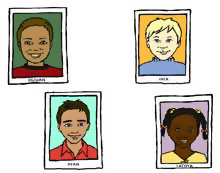How is high-quality instruction integrated into the RTI approach?
Page 11: Effective Instruction at Tier 2
After eight weeks of Tier 1 instruction, Mrs. Hernandez’s progress monitoring data reveal that four students—DeJuan, Jack, Ryan, and LaToya—are not making adequate progress. Although these students will continue to receive high-quality, Tier 1 instruction from Mrs. Hernandez, she has determined that they would benefit from supplemental Tier 2 intervention and continued frequent progress monitoring.
High-Quality Instruction

- Remediate skill deficits
- Preteach and review skills for Tier 1 lessons
- Provide multiple opportunities to practice
- Provide immediate corrective feedback
Just as with Tier 1, Tier 2 instruction should be of high quality. The implementation of high-quality Tier 2 instruction may vary from school to school but is typically delivered in small groups ranging in size from three to five students. However, all schools should implement supplemental interventions, which are based on research-validated instruction, for at least 30 to 45 minutes three to five times a week, depending on the ages of the students. School personnel may need to be creative to identify instructional time for Tier 2 intervention. Two options to consider are:
- Taking time from two consecutive classes (e.g., 15 minutes from social studies and 15 minutes from science)
- Taking time from “specials” (e.g., music, library, art)
In addition to the 90 minutes of core reading instruction provided by Mrs. Hernandez in the general education classroom, DeJuan, Jack, Ryan, and LaToya will receive 30 minutes of Tier 2 intervention with Ms. Washington, the reading specialist. Because Rosa Parks Elementary chose to use the standard protocol approach, the identified struggling readers will receive a standard research-validated instructional program provided in a small-group format. Ms. Washington will provide all four students with the same, empirically validated intervention, which will address all five components of high-quality reading instruction. The schedule below depicts the amount of time she will spend on each of the components.
| Sample Schedule | |
| Phonemic Awareness | 5 minutes |
| Phonics and Word Study | 10 minutes |
| Fluency | 5 minutes |
| Vocabulary | 5 minutes |
| Reading Comprehension | 5 minutes |
For Your Information
In some cases, a larger percentage of general education classroom students may require Tier 2 intervention than would be expected. When this occurs, school professionals should reexamine the quality of the Tier 1 services and make changes accordingly.
 Tier 2 intervention may be provided by the general education teacher or by another trained instructor, within or outside the general education classroom. If Tier 2 intervention is provided by someone other than the general education teacher, collaboration between the teachers is particularly important so that the intervention program is aligned with Tier 1 instruction. For example, Ms. Washington will identify additional, supporting instructional resources (e.g., letter/ sound cards, word cards, strategies specific to working with English Language Learners, and progress monitoring assessments) to supplement the Tier 1 comprehensive core reading program. She will also use these resources to provide extra practice opportunities for students receiving Tier 2 intervention. For instance, if students have worked on the /a/ sound during Tier 1 then the same skill should be reviewed and reinforced during the Tier 2 intervention. The sample lesson activity (below) shows how Ms. Washington’s Tier 2 lesson will reinforce one of the skills taught by Mrs. Hernandez during Tier 1 instruction.
Tier 2 intervention may be provided by the general education teacher or by another trained instructor, within or outside the general education classroom. If Tier 2 intervention is provided by someone other than the general education teacher, collaboration between the teachers is particularly important so that the intervention program is aligned with Tier 1 instruction. For example, Ms. Washington will identify additional, supporting instructional resources (e.g., letter/ sound cards, word cards, strategies specific to working with English Language Learners, and progress monitoring assessments) to supplement the Tier 1 comprehensive core reading program. She will also use these resources to provide extra practice opportunities for students receiving Tier 2 intervention. For instance, if students have worked on the /a/ sound during Tier 1 then the same skill should be reviewed and reinforced during the Tier 2 intervention. The sample lesson activity (below) shows how Ms. Washington’s Tier 2 lesson will reinforce one of the skills taught by Mrs. Hernandez during Tier 1 instruction.
| Tier 2 Intervention | ||||||||
|
| mat | cat | map | pan |
| tap | tack | tan | nap
|
Now look at the table below and compare the phonemic awareness lessons between Tier 1 and Tier 2. Although the lessons seem similar, Tier 2 provides a more intense level of instruction. This is achieved by providing additional attention, focus, and support, and by adjusting the pace of the lesson to match students’ needs. For example, where a Tier 1 lesson might have students practice on three different sounds, a Tier 2 lesson might start with one sound and gradually progress to the second and third sounds once students can demonstrate their understanding of each previous sound. Students have multiple opportunities to participate and respond, and Ms. Washington is able to provide immediate corrective feedback.
Tier 1 Lesson
Phonemic Awareness
- Say the sounds for the following words, and have students say what the word is ([/m/ /a/ /s/ /t/ = mast]: mast, mats, mist, mitts, past, pest, pets, pats).
- Using the same list from above, say the words and have students say the individual sounds (mast = [/m/ /a/ /s/ /t/]).
Tier 2 Lesson
Phonemic Awareness
- Review short-a words with this exercise. Only when students have mastered the /a/ words will she introduce /i/ words.
- Use visual cues to help the students associate the sounds with letter names.
- Provide more opportunities for students to practice.
- After students have mastered consonant-vowel-consonant, add words with the /st/ blend that the general education teacher has already taught (i.e., Tier 1 instruction).
- Preteach sounds that the general education teacher will introduce later in the week.
As indicated in the table above, small-group activities for Tier 1 and Tier 2 instruction appear to have comparable content. However, Tier 1 teachers most likely will not have as much time with their struggling students during small-group instruction (5–20 minutes) as teachers will have during Tier 2 small-group instruction (30–45 minutes). Tier 1 teachers will have to prioritize what the struggling students need to learn or practice during Tier 1 small-group instruction. Therefore, the Tier 1 teacher may be able to cover only one or two core reading components during this short time. Subsequently, because Tier 2 intervention is for a more extended time, the Tier 2 teacher should be able to address most, if not all, of the five components during the intervention.
Listen to Thea Woodruff discuss Tier 1 and Tier 2 instruction (time: 0:32).
Thea Woodruff, PhD
Director, Professional Development and Technical Assistance Teams,
Vaughn Gross Center’s Reading First Project
University of Texas, Austin

Transcript: Thea Woodruff, PhD
They really should look very similar and provide the students with more practice opportunities that are consistent across the two instructional times. You want some consistency across what kids are doing, so you are reinforcing the same skills and having them practice them. Especially with struggling readers, you’re wanting to be consistent in the instruction that you’re providing across these different interventions. If you’re doing different things, it’s going to be difficult—especially for struggling readers—to grasp on to the activities and learn how to do them and get as much out of them if you’re not being consistent.
Frequent Monitoring
 Ms. Washington is responsible for conducting the weekly progress monitoring of those students receiving Tier 2 instruction, which typically lasts 10–12 weeks. However, she and Mrs. Hernandez are responsible for collaborating and making decisions about the students’ instructional needs. At the end of the 10–12-week period, they also are responsible for determining, whether individual students should receive Tier 1 instruction only, whether they should continue to receive another round of Tier 2 intervention, or whether they need more the intensive intervention provided by Tier 3.
Ms. Washington is responsible for conducting the weekly progress monitoring of those students receiving Tier 2 instruction, which typically lasts 10–12 weeks. However, she and Mrs. Hernandez are responsible for collaborating and making decisions about the students’ instructional needs. At the end of the 10–12-week period, they also are responsible for determining, whether individual students should receive Tier 1 instruction only, whether they should continue to receive another round of Tier 2 intervention, or whether they need more the intensive intervention provided by Tier 3.
The table below offers a brief summary of some options for Tier 2 intervention.
| Tier 2 Intervention Options | |
| Who receives instruction | Students who are not making adequate progress with Tier 1 instruction. |
| Amount of daily instruction |
Instruction may vary, depending on the age of the student, from 30–45 minutes per day (+ Tier 1):
|
| When instruction is provided |
Scheduling options for Tier 2 could include:
In the event that a large percentage of students requires Tier 2, the teacher might need to schedule more than one Tier 2 intervention period per day. |
| Duration of instruction |
10 weeks–20 weeks:
|
| How instruction is implemented | Instruction should be implemented with teacher/ student ratios of 1:3–1:5. |
| Frequency of progress monitoring | At least one time every 1–2 weeks |
| Who provides instruction |
Trained personnel may include:
|
| Where students are served | Within or outside the general education classroom |
 Remember, teachers who provide Tier 2 interventions should:
Remember, teachers who provide Tier 2 interventions should: